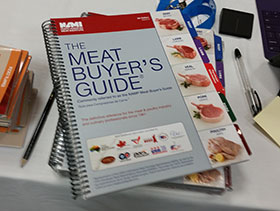



Pork 101: Hands-on Learning Experience Explores Quality, Value
US - Pork quality is affected by what happens to the animals on the farm, during transport and in the plant and that affects the eating experience, reports Carla Wright, Editor, The Pig Site.Attendees at the IPPE 2015 Pork 101 workshop had the opportunity to get a taste of the three-day Pork 101 program offered through universities in the US.
The four-hour hands-on workshop, supported by the North American Meat Institute (NAMI), was led by AMSA members Drs Davey Griffin from Texas A&M University, and Dean Pringle from the University of Georgia.
Pork 101 began in 1997, with input from the National Pork Board.
“It’s a popular program with a mix of attendees that includes chefs, agriculture students, internationals, and buyers,” Dr Griffin said.
“We go over everything that concerns pork quality. Eighty to 90 per cent of our students have no live animal experience. We start with the basics and define terms such as gilt, barrows, sows, etc. We take the students out to look at live pigs. We discourage the students from petting the animals as the following day they’ll see them hanging. We discuss grading and yield, food safety, HACCP plans. We have a gut inspector talk about the inspection side. It gives them the opportunity to see the whole process at the slaughterhouse,” explained Dr Griffin.
“It’s important to understand that pork quality is affected by what happens to the animals in the plant and how that affects the eating experience, and to understand that in a very basic, scientific way,” said Dr Griffin.
“What happens during transport and before slaughter affects the quality of the meat, more so for pigs than for any other species. Short term stress to a pig prior to harvest causes PSE (pale, soft, exudative meat) and long-term stress, such as exposure to cold weather, causes DFD (dark, firm, dry meat). After transport, pigs need about four hours of rest prior to harvest. Beyond that, they’ll start to fight and that will affect meat quality. This has economic implications,” continued Dr Griffin.
“Pigs can become frightened during loading. The pigs will exhibit behavior such as moving to the corners of the pen, trying to escape through small openings in gates and balking at moving objects, shadows, sunlight, changes in flooring, the wind, etc. A thorough understanding of the natural behaviors of pigs and the flight zone are needed for the optimal handling and movement of pigs.”
During Pig 101 the students visit a slaughter house, where they are allowed to take photos and also not deterred from sharing those photos on social media. “It’s important to let people see slaughter. It’s important to be transparent.” The students see the whole process at the slaughter house.
The second day, the students, working in small groups, butcher a whole pig carcass.
“We do bone-in and boneless and value differences. This is the favorite part of the program,” said Dr Griffin.
The students make sausage and brats, learn bacon and ham curing, and also learn enhanced pork technology.
On the last day of Pork 101, the students participate in a blind taste test. During the class, they studied color, firmness, marbling, drip loss and tenderness.

Pork 101 is co-sponsored by the American Association of Meat Processors (AAMP), American Society of Animal Science (ASAS), North American Meat Institute Foundation (NAMIF) and the Southwest Meat Association (SMA).
It is a unique hands-on laboratory designed for industry professionals who want to learn the latest in pork quality and safety. Each session is limited to 38 registrants.
Pork 101 is scheduled to be held from 19 to 21 May 2015 at Texas A&M University, College Station, Texas, USA and 19 to 21 October at Iowa State University, Ames, Iowa.
For more information, please visit: American Meat Science Association








